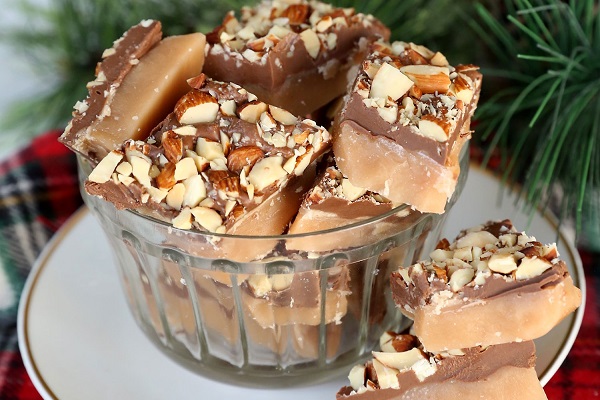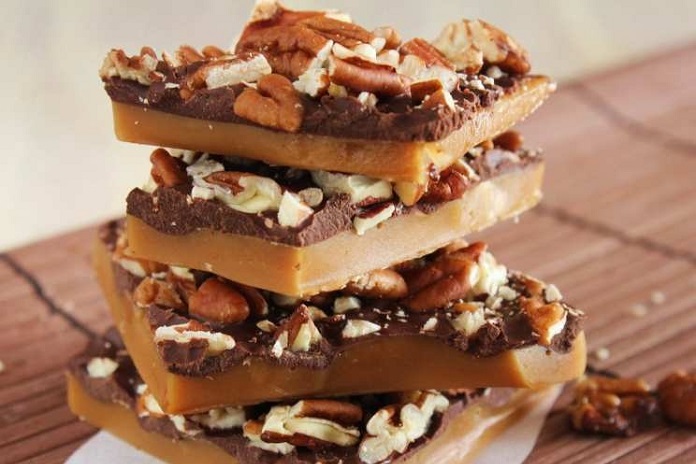On January 8 we celebrates, National English Toffee day a day to enjoy the favourite and delicious Toffee with the great mixture of the Brown Sugar and Butter which is doused in a decadent layer of Chocolate. English Toffee are the everyone’s favorites from all age group of people loves the English Toffee. Do you know that the English toffee enjoyed by millions of people across the U.S. is slightly different from the original?
However this delicious toffee was the first invention of England and later on it was called as American toffee or buttercrunch because of how it is prepared with white sugar and a variety of nuts. However it is siglty different then English Toffee because it does not contains the much nuts, although it is equally delicious.
History of National English Toffee Day
Do you know that the sugar Started in the early age of 19th centuary and The Oxford English Dictionary first mentioned the word ‘toffee’ in the year 1825. Back in 18th century sugar became a much accessible resource in Europe that leads that candies and sweet treats such as English toffee were developed. However it is also said that the candy-making recipes for toffee may have actually originated in Wales and then moved over into England as both were part of Great Britain by this time.
Besides it was simple to make it beacuse of the indregents butter and brown sugar that are caramelized together, so similalry, toffee is simple to make and only requires a few additional ingredients, such as vanilla extract and salt, as well as milk chocolate to spread on top of the toffee.
Toffee is made by caramelizing sugar or molasses with butter and sometimes flour and then heated to the hard crack stage before optionally mixing it with raisins or nuts. It is then poured into a tray to cool into a slab that can be broken into pieces and eaten. The National Confectioners Association recognizes the day as a reminder of the richness of America’s toffee variant and encourages us to indulge in the much-loved confection.
Talking in depth on this topic, English toffee is made without nuts, whereas American and other types of toffee may use nuts so this is only the difference between American and other toffee. But you can have it with or without nuts, making and then munching on some delicious toffee.
During the year 1800s millions of people enjoy English toffee across the U.S. for its chewy and tantalizing nature and arom.
| 1825 (“Toffee” enters the dictionary) | The Oxford dictionary first mentions the word “toffee” and English toffee originates in the U.K. during the 19th century, and the earliest record of toffee is in 1825. |
| 1841 (Sugar Cubes) | Jakob Christof Rad produces the first sugar cube in the world. |
| 19th century (English Toffee becomes popular) | Likely originating in Wales, English Toffee rose in popularity in the 1800s. |
| 1866 (The First Solid-State Chocolate Produced) | The art of confectionery comes into play with the first solid-state chocolate production. |
| 1890 (Mackintosh’s toffee brand is founded) | Marketing English Toffee as a weekend treat, Mackintosh’s owner refers to himself as the “Toffee King”. |
| 1951 (A Novelty Song About Molasses) | The health benefits of Molasses, the main ingredient in toffee, is the subject of a 1951 novelty song titled ‘Black Strap Molasses.’ |
| 1928 (HEATH bars are first sold) | Bayard and Everett Heath make these English Toffee bars using a copper kettle, stirring paddle, marble slab and rolling knife |
| 2005 (English Toffee gets a Harry Potter mention ) | Mrs. Weasley sends a care package of toffee filled Easter eggs in Harry Potter and the Goblet of Fire by J. K. Rowling. |

Classic English Toffee Recipe
Ingredients:
- 1 cup unsalted butter (2 sticks)
- 1 cup granulated sugar
- 1/4 cup water
- 1/4 teaspoon salt
- 1 teaspoon vanilla extract
- 1 cup semi-sweet chocolate chips
- 1/2 cup chopped nuts (e.g., almonds or pecans) – optional
How to make:
- Line a baking sheet with parchment paper or a silicone baking mat for easy removal.
- In a medium saucepan, melt the butter over medium heat. Once melted, add the sugar, water, and salt. Stir to combine.
- Continue to cook the mixture, stirring constantly, until it reaches a temperature of 300°F (hard crack stage) on a candy thermometer. This usually takes about 10–15 minutes. The mixture should turn a rich amber color.
- Once it reaches the right temperature, remove the saucepan from heat and carefully stir in the vanilla extract.
- Quickly pour the toffee mixture onto the prepared baking sheet. Use a spatula to spread it into an even layer.
- Immediately sprinkle the chocolate chips over the hot toffee. Let them sit for a minute to soften, then spread the melted chocolate evenly across the surface.
- If using, sprinkle the chopped nuts over the chocolate layer, gently pressing them in.
- Allow the toffee to cool completely at room temperature until hardened. Once set, break it into pieces.
- Store the toffee in an airtight container at room temperature for up to two weeks.
5 Fun Facts About Sweets
-
Buttery goodness- Did you know that one of the main ingredients in English toffee, the fat from the butter makes toffee richer!
-
Mediterranean rum- Toffee got its name from ‘tafia,’ a Mediterranean rum made from molasses used as a flavoring agent in candy.
-
Honey, let’s make sweets- Before sugar was readily available in the ancient western world, the Egyptians and Greeks used honey to make candy and sweets.
-
The origin of the word ‘candy’- However, Sugar and desserts have a long history in India. People in India developed the technology to produce sugar crystals that they call ‘khanda,’ which is the source of the word ‘candy.’
-
Origin unknown- National Confectioners Association recognizes National English Toffee Day, the founders and origin are unknown.
Conclusion
How is English toffee different from other types of toffee?
Are there any recipes for making English toffee at home?
Yes! Many recipes are available online, and most require simple ingredients like sugar, butter, and vanilla.
Can I find vegan or dairy-free options?
Yes! There are vegan recipes available that use plant-based butter and alternative sweeteners, so you can enjoy English toffee while accommodating dietary preferences.
Can I use margarine instead of butter?
While margarine can be used, butter is recommended for the best flavor and texture in traditional English toffee.
How long does homemade toffee last?
Homemade English toffee can last up to two weeks when stored in an airtight container at room temperature. For longer storage, you can freeze it for up to three months.
Can I add flavorings to the toffee?
Yes, You can experiment with different extracts, like almond or orange, to create unique flavors. Just add them at the same time as the vanilla.
Also, read more about National Tater Tot Day – February 2, 2025
